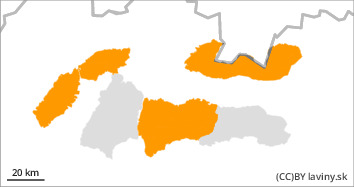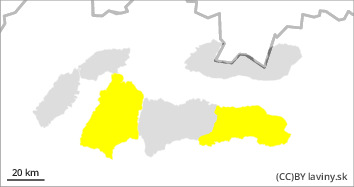
Danger level
 |
|  |  | |||||
|  |  |

Watch out for wind-wound slabs. There is also a risk of spontaneous large avalanches from new snow.
In the Western, High, western part of the Low Tatras and Mala Fatra there is an increased avalanche danger above the forest border, i.e. the 3rd degree. The main avalanche problem remains wind-blown snow. In recent days, it has transported large amounts of snow to the leeward sides of ridges, places under glass walls and narrow couloirs. Especially dangerous are the exposures of S, SE, SW and E orientations. Especially in these places there are hard wind-beaten slabs in which stresses propagate very well. Loosening of these is already possible with a small additional load, especially on steep slopes. Avalanches from new snow deposited on top of the hard layer from the previous days are also threatening. In some cases, medium avalanches are threatened, exceptionally large spontaneous avalanches. Mountain terrain is not recommended for inexperienced hikers/ski mountaineers.
Snowpack
Between 20 and 50 cm of new, mostly powdery snow has fallen in our mountains in the last 48 hours. However, this is very unevenly distributed due to strong winds. The mountain ridges have been blown into hard to icy ground. In narrow troughs and where wind speeds have been lower, more powdery snow will be locally piled up. In valleys, there are wind-beaten slabs that will be rusty. Most of the new snow is blown into the forest zone. Here, the snow is loose powdery and is breaking through to a hard base.
Tendency
As the weather warms up, the avalanche situation will stabilise slightly.
Compiled by : Pavel Bet'ko



